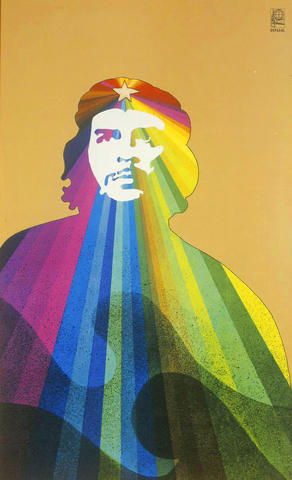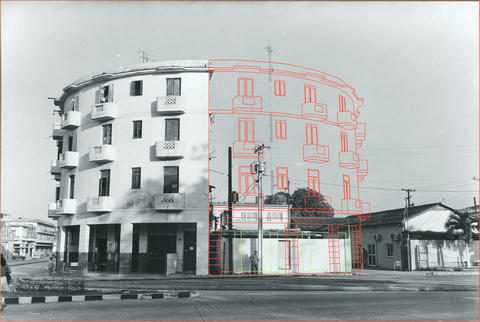I mages of boats and the horizon are a relative constant in Cuban art. For Cubans they're often an expression of longing for life beyond a geographically and politically enclosed space.
For the rare Americans who ever see Cuban art, the images can be a reminder of a place they may be unlikely to visit.
For the next five months, witnessing at least one aspect of Cuba will in theory be a bit easier for Americans. Cuba! Art and History from 1868 to Today, an exhibition that just opened at the Montreal Museum of Fine Arts, offers more than 400 images and objects from the island that Christopher Columbus is said to have called "the most beautiful land that eyes have ever seen."

PHOTOS: NY TIMES NEWS SERVICE
Many of the paintings were lent by the National Museum of Fine Arts in Havana with encouragement from Cuban officials who want to promote the notion of Cuban culture, said Moraima Clavijo Colom, the museum director. "That Cuba was not just a place of sun, beaches, rum and dancing," she said.
It may seem provocative to dangle this forbidden fruit near the border of the US, whose citizens can face fines for traveling to Cuba under the latest version of a 46-year-old trade embargo. But Nathalie Bondil, the director of the Montreal museum and the curator of the exhibition, said "It's not a political show. It's just a show."
She declined to speculate on whether any museum in the US could cooperate legally on such a scale with a comparable Cuban institution. "It's not a question," she said. "Canada is a different country." Canada is one of Cuba's most important trading partners, and Canadians make up the largest group of tourists who visit Cuba.

PHOTOS: NY TIMES NEWS SERVICE
Still, given Cuba's history, any exhibition of work produced there seems to become a show about Cuba and Cuban identity. The date of 1868 was anything but arbitrary, Bondil noted: it was the year in which Cubans in the town of Bayamo first declared independence from Spain. And by including "art and history" in the exhibition title, the curators also signal that the subject of much Cuban art is Cuba and Cubans.
"Cuban art cannot escape the necessary negotiation with the historical situation in which it occurs - that seems to be the defining element," said Stephane Aquin, the Montreal curator who selected the works made after 1959. "The best that I've seen of Cuban art is always negotiating its space or reacting to its historical condition."
Like any survey of art and history in a Western country, this one rolls through landscape painting, portraiture and genre scenes, beginning with folkloric images of Afro-Cuban rural life. (Slavery was not banned in Cuba until 1888.) Yet two mediums help to set Cuba and this exhibition apart from other marches through history.
Photographers have documented Cuban life since the middle of the 19th century, and some 200 photographs lent by the Fototeca de Cuba in Havana guide visitors from the 1860s to the present. Among them are Walker Evans' grim images of Havana street life, included in Carleton Beals' 1933 book, The Crime of Cuba, a lament for ordinary people living under the dictatorship of Gerardo Machado y Morales (1925-1933).
There are also abundant images from an inventive graphic arts industry that advertised to a growing consumer population in the 1920s and 1930s, deploying the new vocabularies of Modernism and Surrealism. Cuba's vibrant poster culture was so strong that it survived the transition to one-party Communism after Fidel Castro's takeover in 1959.
Yet if there is a star to be celebrated in this show, it is not Castro but Wifredo Lam, born in 1902 of Chinese and Afro-Cuban parents. He traveled to Europe to study art in 1923, joined Andre Breton's Surrealist circle, fought in the Spanish Civil War and painted in a Surrealist style that caught Picasso's eye with its use of African imagery, which resembled forms that Picasso borrowed earlier in the century.
The exhibition's centerpiece is Cuba Colectiva, a gigantic 1967 mural on six panels that was initially conceived by Lam and created by 100 Cuban and European artists for the Salon de Mai, an annual exhibition. Although artists were making "collective works" in the US and Europe at the time, often in protest of the Vietnam War, this mural was a tribute to a romantic view of Cuban Socialism that inspired many Europeans artists at the time.
The huge mural traveled the following year from Cuba to France, where curators said it was taken off display after a few hours to avoid damage in the May 1968 student uprising. Back in Havana, it was eventually placed in storage. When the museum was emptied in 1999 for renovation, the mural and its frame were found to have been invaded by termites. Without money to restore it, the Cubans found a Parisian dealer to underwrite the job, and the mural is being shown for the first time outside Cuba since its conservation.
Like the mural, much Cuban art since 1959 has been in the service of the Castro regime, either in Socialist-Realist styles through the 1970s (when Russians taught in art academies there) or in a Pop Art style adapted to official portraiture of figures like Castro and Che Guevara.
"It's a Pop form of vocabulary - the flashy colors, the bright letters," said Aquin of the Montreal museum. "They were taking the Pop aesthetic and functionalizing it."
Less functional ideologically are works made by contemporary artists who are beginning to find markets abroad after years during which their only client was the state. In the 1980s and 1990s, as Soviet aid dried up, art materials were particularly scarce, and mixed-media artists like Alexis Leyva (Kcho) and the duo, Los Carpinteros (all represented in the Montreal show) constructed work from whatever they could scavenge. It was a new Cuban hybridization: a mix of found objects and Arte Povera. "I bought a sculpture, and I asked the artist if he could put it in bubble wrap for me," said Howard Farber, an American collector. "He didn't know what I was talking about."
While most Cuban artists struggle, some are thriving, like Carlos Garaicoa, who takes photographs of empty sites where buildings once stood in Havana and then constructs the former structures in delicate thread atop the pictures. Garaicoa, 40, has had solo exhibitions in the US that included his large installations of sculptural urban ensembles - he calls them "utopian cities" - but he has not been granted a visa to enter the country. One of his clusters is the final installation in the Montreal museum's show.
Garaicoa's dealer, Lea Freid of Lombard-Freid Projects, suggested that this softly illuminated city in miniature could be an image of a place awaiting Cubans one day after the death of Castro, or after the end of the US embargo.

May 26 to June 1 When the Qing Dynasty first took control over many parts of Taiwan in 1684, it roughly continued the Kingdom of Tungning’s administrative borders (see below), setting up one prefecture and three counties. The actual area of control covered today’s Chiayi, Tainan and Kaohsiung. The administrative center was in Taiwan Prefecture, in today’s Tainan. But as Han settlement expanded and due to rebellions and other international incidents, the administrative units became more complex. By the time Taiwan became a province of the Qing in 1887, there were three prefectures, eleven counties, three subprefectures and one directly-administered prefecture, with

It’s an enormous dome of colorful glass, something between the Sistine Chapel and a Marc Chagall fresco. And yet, it’s just a subway station. Formosa Boulevard is the heart of Kaohsiung’s mass transit system. In metro terms, it’s modest: the only transfer station in a network with just two lines. But it’s a landmark nonetheless: a civic space that serves as much more than a point of transit. On a hot Sunday, the corridors and vast halls are filled with a market selling everything from second-hand clothes to toys and house decorations. It’s just one of the many events the station hosts,

Two moves show Taichung Mayor Lu Shiow-yen (盧秀燕) is gunning for Chinese Nationalist Party (KMT) party chair and the 2028 presidential election. Technically, these are not yet “officially” official, but by the rules of Taiwan politics, she is now on the dance floor. Earlier this month Lu confirmed in an interview in Japan’s Nikkei that she was considering running for KMT chair. This is not new news, but according to reports from her camp she previously was still considering the case for and against running. By choosing a respected, international news outlet, she declared it to the world. While the outside world

Through art and storytelling, La Benida Hui empowers children to become environmental heroes, using everything from SpongeBob to microorganisms to reimagine their relationship with nature. “I tell the students that they have superpowers. It needs to be emphasized that their choices can make a difference,” says Hui, an environmental artist and education specialist. For her second year as Badou Elementary’s artist in residence, Hui leads creative lessons on environmental protection, where students reflect on their relationship with nature and transform beach waste into artworks. Standing in lush green hills overlooking the ocean with land extending into the intertidal zone, the school in Keelung